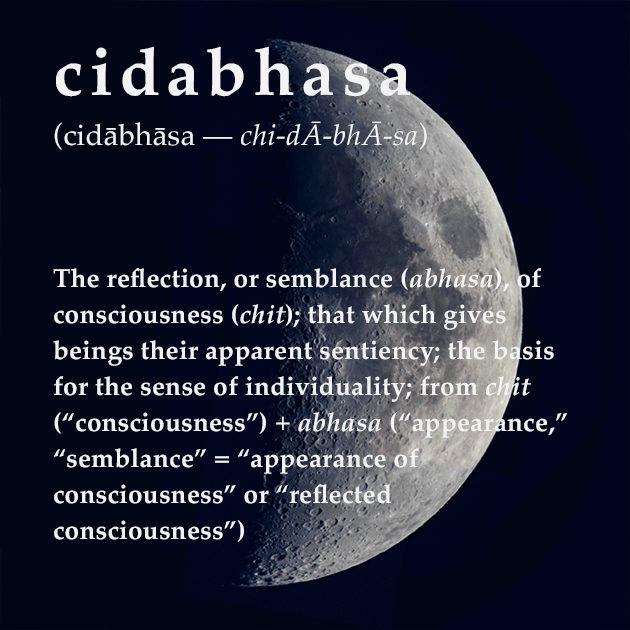What is Chidabhasa? Reflected Consciousness in Advaita
- Daniel McKenzie

- Mar 29
- 3 min read
Updated: Dec 11

Chidhabhasa (cidhābhāsa) is a compound Sanskrit word derived from chit (consciousness) and abhasa (semblance; appearance; emanation). The word constitutes the important reflected-consciousness teaching in Advaita Vedanta, showing how pure consciousness vivifies the gross and subtle bodies, and how atman (pure consciousness) appears as many.
The concept of chidabhasa is often explained through the reflection theory (pratibimba-vada), a teaching model developed in post-Shankara Advaita. While Shankaracharya does not explicitly use the term, he frequently employs reflection metaphors, such as sunlight reflected in water, to illustrate how pure consciousness appears as the individual self. The term is formally introduced in Panchadashi by Vidyaranya, and is also used in Drg Drshya Viveka attributed to the same author.
The reflected-consciousness teaching outlines three principles:
OC (original consciousness), also known as chit (pure awareness), atman or the true Self.
RM (reflecting medium), which refers to the subtle body, and more specifically, the mind or intellect (buddhi). The mind acts like a mirror, which is inert until illumined by OC, which makes it appear alive.
RC (reflected consciousness) is the apparent consciousness seen in the reflecting medium—like a mirror catching sunlight. It’s the byproduct of the mind’s proximity to the Self, giving the impression that the mirror is shining, when in fact, it’s OC that is shining and RM is only reflecting it. The traditional analogy is the moon, which appears to be shining thanks to its proximity to the sun. It’s said that the moon “borrows” the light from the original source.
Chidabhasa is what makes cognition and transaction possible. It is the operative knower (jnata) in experience. It says, “I know,” “I feel,” “I choose,” but, just like the moon, these are all borrowed powers. While chidabhasa animates the mind and “gives life,” it is also responsible for the fundamental error of mistaking the reflection (RC) for the Self, giving rise to the ego (ahankara) and the sense of doership. As individuals (jivas), we know we are conscious, but identify with the RC instead of the OC. But chidabhasa is only a semblance—it’s not real. It’s like the moon claiming to generate its own light.
Chidabhasa is neither real nor unreal. It’s not real (sat) because it disappears in deep sleep, coma and after gaining Self-knowledge. It’s not unreal (asat) because we experience it everyday during our waking hours. Advaita Vedanta resolves this predicament by saying it’s mithya (apparently real). Even though we may experience chidabhasa, we know it’s dependent on OC for illumination, and on RM for manifestation.
The essential error is attributing the properties of chidabhasa to chit (pure consciousness). The objective of the seeker is then, to realign the mind’s understanding, from “I am the I-sense/the ego.”—(RC), to “I am the light that illumines this reflection and all reflections.”—(OC).
Chidabhasa is like the glint of the sun in a shimmering puddle—brilliant, shifting and illusory. It dances around calling itself “me,” forgetting the vast sun above. But once the truth is known, it doesn’t stop shining—it just stops claiming its independence.
Root & Meaning
Sanskrit chit (consciousness) + abhasa (appearance, semblance) = “appearance of consciousness” or “reflected consciousness.”
Scriptural References
Brihadaranyaka Upanishad (4.3.7, 4.3.23) – Describes the Self as the light by which the mind and senses are illumined, implying the reflected-consciousness principle.
Katha Upanishad (2.2.15) – States that the Self shines and everything else shines after it, much like the moon reflects sunlight.
Mundaka Upanishad (2.2.10) – Compares the mind and intellect to instruments that borrow light from the Self.
Panchadashi (Chapter 2, Chidabhasa-prakarana) – Systematically explains the original consciousness, reflecting medium, and reflected consciousness model.
Drg Drshya Viveka (Verses 8–11) – Uses the reflection metaphor to distinguish the Self from the reflected “I-sense.”
Bhagavad Gita (15.12–15) – Uses the moon–sun analogy to show how all cognition depends on the original light of consciousness.
Traditional View
Chidabhasa is not independent reality; it is dependent on both chit (the original consciousness) and the mind. It belongs to the realm of mithya (dependent existence).
Vedantic Analysis
The chidabhasa makes empirical experience possible but is ultimately unreal in itself — like a reflection in a mirror. Recognizing the difference between chit and chidabhasa is essential to Self-knowledge.
Common Misunderstandings
Thinking chidabhasa is an independent entity.
Equating chidabhasa with pure consciousness.
Believing chidabhasa can exist without a functioning mind.
Vedantic Resolution
The real “I” is chit, the unreflected, limitless awareness. The reflection is just an appearance in the mind and does not define the Self.
